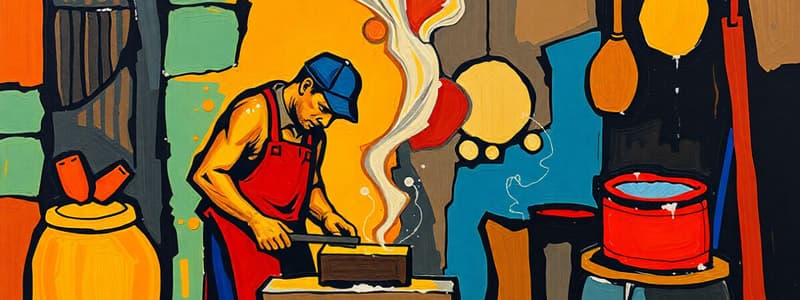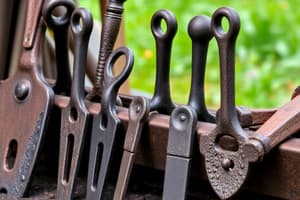Podcast
Questions and Answers
What role did iron tools play in agriculture during the early use of iron?
What role did iron tools play in agriculture during the early use of iron?
- They were mostly effective in urban development.
- They helped in increasing agricultural production. (correct)
- They created a need for more livestock.
- They were primarily used for decorative purposes.
Which of the following was NOT a type of iron tool mentioned?
Which of the following was NOT a type of iron tool mentioned?
- Sickle
- Hammer (correct)
- Ploughshare
- Axe
What was the primary purpose of the iron ploughshare?
What was the primary purpose of the iron ploughshare?
- To serve as a weapon.
- To build tools for blacksmiths.
- To create decorative items.
- To aid in increasing agricultural production. (correct)
Around how many years ago did the use of iron begin in the subcontinent?
Around how many years ago did the use of iron begin in the subcontinent?
What type of structures were built to facilitate irrigation during the early use of iron?
What type of structures were built to facilitate irrigation during the early use of iron?
What evidence indicates the growing use of iron tools about 2500 years ago?
What evidence indicates the growing use of iron tools about 2500 years ago?
What was commonly observed at the blacksmith’s shop where Prabhakar sat?
What was commonly observed at the blacksmith’s shop where Prabhakar sat?
Which of the following iron tools was primarily used for clearing forests?
Which of the following iron tools was primarily used for clearing forests?
What role did kings play in the construction of irrigation works?
What role did kings play in the construction of irrigation works?
Which term refers to large landowners in the Tamil region?
Which term refers to large landowners in the Tamil region?
What was the hereditary position in villages known as?
What was the hereditary position in villages known as?
What term is used for ordinary ploughmen in the Tamil region?
What term is used for ordinary ploughmen in the Tamil region?
What increased as production rose due to irrigation?
What increased as production rose due to irrigation?
Who employed local fishermen to steer ships in Barygaza?
Who employed local fishermen to steer ships in Barygaza?
What is a common responsibility of the grama bhojaka?
What is a common responsibility of the grama bhojaka?
What is one of the benefits for farmers when irrigation is implemented?
What is one of the benefits for farmers when irrigation is implemented?
Which of the following items was NOT imported into Barygaza?
Which of the following items was NOT imported into Barygaza?
What was a significant export from Barygaza?
What was a significant export from Barygaza?
Which group was primarily referenced as landless laborers in the Tamil region?
Which group was primarily referenced as landless laborers in the Tamil region?
Why were gifts sent to the king by merchants?
Why were gifts sent to the king by merchants?
Which of the following items highlights the wealth of South India?
Which of the following items highlights the wealth of South India?
What does the term 'black gold' refer to in the context of trade?
What does the term 'black gold' refer to in the context of trade?
What form of transportation did traders use to move goods to Rome?
What form of transportation did traders use to move goods to Rome?
Which of the following is a likely reason for the discovery of Roman gold coins in South India?
Which of the following is a likely reason for the discovery of Roman gold coins in South India?
Which of the following items was NOT mentioned as being brought into Puhar?
Which of the following items was NOT mentioned as being brought into Puhar?
What advantage did sailors use to improve the speed of their voyages?
What advantage did sailors use to improve the speed of their voyages?
What was a key factor in the wealth and power of chiefs and kings in the southern subcontinent?
What was a key factor in the wealth and power of chiefs and kings in the southern subcontinent?
Which of the following correctly identifies a type of good brought by sea, as described in the poem?
Which of the following correctly identifies a type of good brought by sea, as described in the poem?
What geographic feature significantly contributed to trade in the southern half of the subcontinent?
What geographic feature significantly contributed to trade in the southern half of the subcontinent?
Which item mentioned in the poem was sourced from the Himalayas?
Which item mentioned in the poem was sourced from the Himalayas?
What type of vessels were built for long sea journeys according to the content?
What type of vessels were built for long sea journeys according to the content?
Which river is mentioned as being fertile in the southern subcontinent?
Which river is mentioned as being fertile in the southern subcontinent?
What was one primary reason the rulers wanted to control the Silk Route?
What was one primary reason the rulers wanted to control the Silk Route?
Who were the best-known rulers associated with the control of the Silk Route?
Who were the best-known rulers associated with the control of the Silk Route?
What two major centers of power did the Kushanas have?
What two major centers of power did the Kushanas have?
Which geographic area did the Silk Route branch extend into during the Kushana rule?
Which geographic area did the Silk Route branch extend into during the Kushana rule?
What goods were primarily shipped westwards from the Indus seaports?
What goods were primarily shipped westwards from the Indus seaports?
What role did rulers often play regarding traders on the Silk Route?
What role did rulers often play regarding traders on the Silk Route?
What was the significance of Taxila during the Kushana rule?
What was the significance of Taxila during the Kushana rule?
What was a key benefit to kings controlling the Silk Route aside from taxes?
What was a key benefit to kings controlling the Silk Route aside from taxes?
Flashcards are hidden until you start studying
Study Notes
Villages, Towns, and Trade
- Prabhakar observes blacksmiths, illustrating local craftsmanship with iron tools like axes and sickles.
- Iron usage began around 3000 years ago in the subcontinent, with significant collections found in megalithic burials.
- By 2500 years ago, iron tools such as axes and ploughshares were increasingly utilized, enhancing agricultural productivity.
- Irrigation systems were developed to support agricultural growth, including canals, wells, tanks, and artificial lakes.
- Kings required funds for military and administrative purposes, leading to increased agricultural productivity to meet tax demands.
- In Tamil Nadu, social structure involved three main groups: vellalar (large landowners), uzhavar (ploughmen), and kadaisiyar/adimai (landless laborers/slaves).
- In northern regions, the village headman was referred to as grama bhojaka, often the largest landowner, with a hereditary title.
- Barygaza functioned as a crucial trading port, importing goods like wine, copper, and silk, and exporting plants, ivory, and perfumes.
- Traders played a vital role in distributing Northern Black Polished Ware, a type of fine pottery found across the subcontinent.
- Southern India was famous for gold, spices (especially pepper), and precious stones, facilitating trade with the Roman Empire, often referred to as 'black gold.'
- Sangam poems provide insights into trade, listing various valuable goods such as pepper, gems, and foodstuffs brought to ports like Puhar.
- Sea routes were essential for trade, with sailors utilizing monsoon winds for faster travel across the Arabian Sea and Bay of Bengal.
- The Kaveri River valley was particularly fertile, leading to the rise of powerful local chiefs and kings controlling trade routes and coasts.
- The Kushanas, influential rulers around 2000 years ago, controlled parts of the Silk Route, benefiting from trader taxes and ensuring their protection.
- The Silk Route extended from Central Asia to the mouth of the Indus River, facilitating the flow of silk to the Roman Empire.
Studying That Suits You
Use AI to generate personalized quizzes and flashcards to suit your learning preferences.

